30th – Brazil – 1994
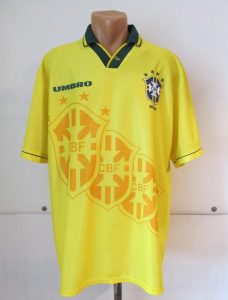 |
After a fairly tame, but refreshing home shirt in 1991, Umbro went with this striking design for USA 94. The shirt pictured was released after the World Cup with a fourth star added above the badge, and a fourth crest across the front to represent each of Brazil’s triumphs at the FIFA World Cup following the penalty shoot-out win in 1994. Nike replaced Umbro in 1997, and have yet to release anything quite as adventurous. |
29th – Nigeria – 2018
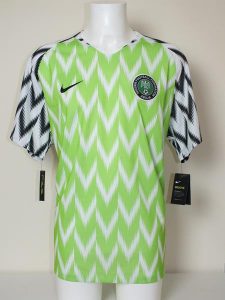 |
Nigeria shirts have featured several times in this list thanks to their exciting designs in the mid 90s. This bold effort from Nike was released for the 2018 World Cup and created a mad scrambled at Nike Town on Oxford Street with fans queueing around the block to get their hands one on. With shirts on eBay fetching over £150 the market was soon flooded with fakes. Similar to Nike’s 1994 shirt, this one take inspiration from the ‘Super Eagles’ with the feather pattern throughout, and a shade of green not used since the 2002 World Cup. |
28th – Argentina – 1998
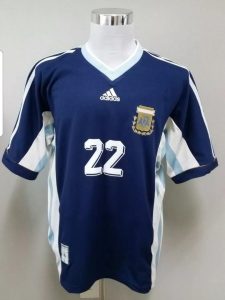 |
Whilst this shirt is an Adidas template used by many other national team, the colour scheme works really well, especially with the gold on the crest. |
27th – Italy – 1981
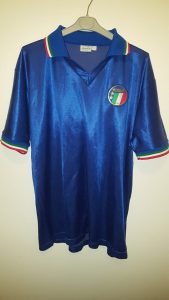 |
In 1981 Italy aded a green, white and red trim to the collar and cuffs of their previously plain blue shirts. The shirts remained pretty much unchanged until 1991 other than the badge becoming circular. |
26th – South Korea – 1994
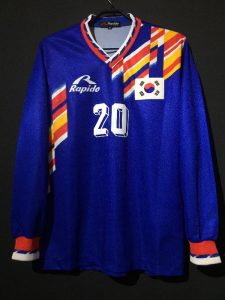 |
Rapido made the shirts for the South Korean national team in the early 90s producing a run of stunning designs, seemingly in competition with neighbours Japan to see who could design the most striking shirt. This shirt was available in blue, white and red, with the white best known for the group stage draws with Spain and Bolivia. |
25th – France – 1998
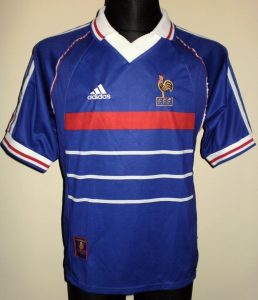 |
A hark back to the 1982 shirt, France wore this well executed tribute as the won the World Cup as hosts. Several other countries including New Zealand, Chad and the Philippines wore the same template. |
24th – Bhutan – 2015
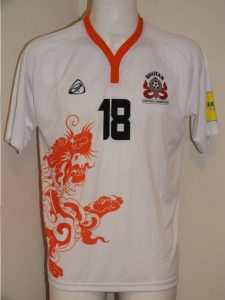 |
Bhutan are one of one of the newest members of FIFA, joining at the beginning of the millennium. Since then they have a pretty ropey track record, with heavy defeats such as the 20-0 loss to Kuwait in an Asian Cup qualifier. Bhutan’s first attempt at World Cup qualification came in 2015, with a two-legged tie that saw them beat Sri Lanka home and away, making them briefly the only national team with a 100% record in World Cup games.
The shirts worn for those games were made by Thailand’s Ego Sports featuring the dragon from the national flag. Bhutan soon moved back to FBT, but have continued to wear shirts featuring the dragon making it one of the most unique shirt themes in national football. |
23rd – Japan – 1996
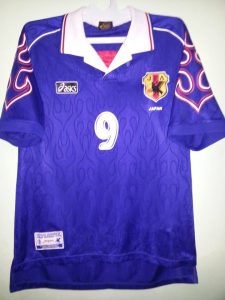 |
This Japan flames shirts is fondly remembered by shirt collectors, and commonly associated with Japan’s World Cup debut at France 1998, but it actually first made an appearance against Yugoslavia in the 1996 Kirin Cup. Once again the same design was produced by Puma, Adidas and ASICS. Their were minor changes made in 1998, with the white piping added. There’s no doubt that if goalkeeper shirts were permitted in the vote they would be right up there. |
22nd – Ivory Coast – 1998
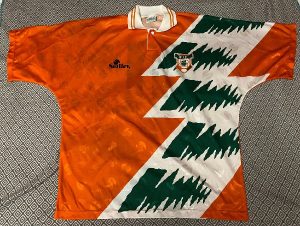 |
Saillev are best known for their work with Portuguese sides Benfica, Sporting Lisbon and FC Porto. How they ended up producing shirts for the Ivory Coast I don’t know, but I’m glad they did. The Elephants wore some fantastic designs during the 90s, with this one making an appearance against Angola at the 1998 African Cup of Nations. Strangely they wore Kappa in the other 3 fixtures. |
21st – Brazil – 1970
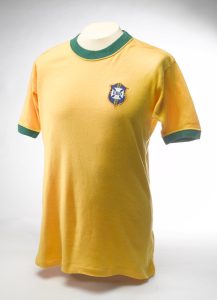 |
From a design point of view there’s not a huge amount going on, but the simple green collar and cuffs make this shirt instantly recognisable as a Brazil shirt. Following the World Cup win in 1970, three stars were added above the crest. The Brazil shirt remained pretty cut unchanged with its round collar until 1986, except for a short time when Adidas added their three stripes circa 1980. |
